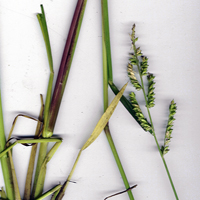Junglerice (<em>Echinochloa colona</em> L.) seedling emergence model as a tool to optimize pre-emergent herbicide application
DOI:
https://doi.org/10.4081/ija.2021.1845Keywords:
Chemical weed control, critical timing, residual herbicides.Abstract
Junglerice (Echinochloa colona), one of the worst and most problematic weeds globally, causes significant economic losses due to yield loss and control cost increase. Taking into account that this weed emerges in approximately five months - from September to January -, and considering that reducing herbicide use is key in the current intensification of agricultural production systems, the present study was carried out under the hypothesis that there should be an optimal moment for pre-emergent herbicide application to achieve maximum weed control effectiveness and efficiency. Therefore, experiments were carried out from August 2016 to January 2021 in Pergamino, Buenos Aires province, Argentina, using a double-logistic emergence model of junglerice seedlings. Bicyclopyrone plus s-metolachlor, clomazone, and pyroxasulfone plus saflufenacil were applied at different times between 92 and 478 growing degree days (GDDs). Single applications between 348 and 399 GDD were observed to reduce junglerice seedling emergence by 85-99%, depending on the herbicide used. Such a seedling emergence reduction could be a convenient strategy to provide significant weed suppression in the field in combination with a competitive crop and within a sustainable production system. The results of the present study lead to the conclusion that using predictive models for pre-emergent herbicide applications ensures more effective use of herbicides and reduces the amounts of herbicides used and the risks of selecting herbicide-resistant junglerice populations.
Highlights
- Weed occurrence indirectly increases the number of herbicide applications in Argentina.
- Reducing the number and volume of herbicide applications contributes to mitigating environmental impact in the short term.
- There is a critical time during weed emergence in which chemical control via herbicide application is most effective.
- Seedling emergence models are useful management tools to predict critical timing for weed control.
Downloads
References
Beckie HJ, 2020. Herbicide resistance in plants. Plants 9:435.
Chauhan BS, 2020. Grand Challenges in Weed Management. Front. Agron. 1:3.
Congreve M, Cameron J, 2019. Soil behavior of pre-emergent herbicides in Australian farming systems - A national reference manual for agronomic advisers. 2nd ed. Grains Research and Development Corporation publication, Australia.
De Corby KA, Van Acker RC, Brule-Babel AL, Friesen LF, 2007. Emergence timing and recruitment of volunteer spring wheat. Weed Sci. 55:60-9.
Di Rienzo JA, Macchiavelli RE, Casanoves F, 2017. Modelos lineales generalizados mixtos: aplicaciones en InfoStat. 1st ed. Digital book, Córdoba, Argentina. 101 p.
Di Rienzo JA, Casanoves F, Balzarini MG, Gonzalez L, Tablada M, Robledo CW, 2020. InfoStat versión 2020p. Centro de Transferencia InfoStat, FCA, Universidad Nacional de Córdoba, Argentina.
Esqueda VA, 1999. Control de malezas en caña de azúcar con clomazone y ametrina. Agron. Mesoam. 10:23-30.
Esqueda VA, 2000. Control de malezas en arroz de temporal con clomazone, solo y en mezcla con propanil y 2,4-D. Agron. Mesoam. 11:51-6.
Forcella F, Benech-Arnold RL, Sanchez R, Ghersa CM. 2000. Modeling seedling emergence. Field Crop. Res. 67:123-39.
González-Andújar JL, Fernandez-Quintanilla C, Bastida F, Calvo R, Izquierdo J, and Lezaun JA, 2011. Assessment of a decision support system for chemical control of annual ryegrass (Lolium rigidum) in winter cereals. Weed Res. 51:304-9.
González-Andújar JL, Chantre G, Morvillo C, Blanco AM, Forcella F. 2016. Predicting field weed emergence with empirical models and soft computing techniques. Weed Res. 56:415-23.
Grundy A, 2003. Predicting weed emergence: a review of approaches and future challenges. Weed Res. 43:1-11.
Izquierdo J, González-Andújar JL, Bastida F, Lezaún JA, Sánchez del Arco MJ, 2009. A thermal time model to predict corn poppy (Papaver rhoeas) emergence in cereal fields. Weed Sci. 57:660-4.
Lewis KA, Tzilivakis J, Warner D, Green A, 2016. An international database for pesticide risk assessments and management. Hum. Ecol. Risk Assess. 22:1050-64.
Myers MW, Curran WS, Van Gessel MJ, Calvin DD, Mortensen DA, Majek BA, Karsten HD, Roth GW, 2004. Predicting weed emergence for eight annual species in the northeastern United States. Weed Sci. 52:913-9.
Nazarko OM, Van Acker RC, Entz MH, 2005. Strategies and tactics for herbicide use reduction in field crops in Canada: a review. Can. J. Plant Sci. 85:457-79.
Peerzada AM, Bajwa AA, Ali HH, Chauhan BS, 2016. Biology, impact, and management of Echinochloa colona (L.) Link. Crop Prot. 83:56-66.
Picapietra G, Acciaresi HA, and González-Andújar JL, 2020. Predicting junglerice (Echinochloa colona L.) emergence as a function of thermal time in the humid pampas of Argentina. Int. J. Pest Manage. [Epub ahead of print].
Principiano MA, Acciaresi HA, 2017. Costo financiero e impacto ambiental del control de malezas en diferentes secuencias de cultivos en el NO de la provincia de Buenos Aires. Rev. Tecnol. Agropec. 10:37-41.
Rao AN, Johnson DE, Sivaprasad B, Ladha JK, Mortimer AM, 2007. Weed management in direct-seeded rice. Adv. Agron. 93:153-255.
Santos FM, Marchesan E, Machado SLO, Avila LA, Zanella R, Gonçalves FF, 2008. Persistência dos herbicidas imazethapyr e clomazone em lâmina de água do arroz irrigado. Planta Daninha 26:875-81.
SMN, 2021. Servicio Meteorológico Nacional. Available from: https://www.smn.gob.ar/.
Stewart CL, Nurse RE, Van Eerd LL, Vyn RJ, Sikkema PH, 2011. Weed control, environmental impact, and economics of weed management strategies in glyphosate-resistant soybean. Weed Tech. 25:535-41.
Wiles LJ, 2004. Economics of weed management: principles and practices. Weed Tech. 18:1403-7.
Zhu Y, Wu J, Han L, Wang X, Li W, Guo H, Wei H, 2020. Nanozyme sensor arrays based on heteroatom-doped graphene for detecting pesticides. Anal. Chem. 92:7444-52.

Published
How to Cite
Issue
Section
License
Copyright (c) 2021 The Author(s)

This work is licensed under a Creative Commons Attribution-NonCommercial 4.0 International License.
PAGEPress has chosen to apply the Creative Commons Attribution NonCommercial 4.0 International License (CC BY-NC 4.0) to all manuscripts to be published.
